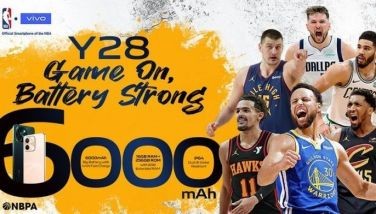Are we ready for the future?
March 31, 2004 | 12:00am
Are Filipinos ready for the wireless next wave?
This early, the government is already looking at a regulatory framework that will govern 3G, or the third generation of wireless communication technology.
So what is 3G? It refers to pending improvements in wireless data and voice communications through any of a variety of proposed standards. The immediate goal is to raise transmission speeds from 9.5K to 2M bit/sec.
It is also defined as a radio communications technology that will create a "bit pipe" for providing mobile access to Internet-based services. It will enhance and extend mobility in many areas of our lives.
In the near future, mobility won’t be an add-on: it will become a fundamental aspect of many services. Expect high-speed access to the Internet, entertainment, information and electronic commerce (e-commerce) services wherever we are – not just at our desktop computers, home PCs or television sets.
3G services are expected to add an invaluable mobile dimension to services that are already becoming an integral part of modern business life: Internet and Intranet access, video-conferencing, and interactive application sharing.
To better understand 3G, let us go back and review the evolution of wireless communications technology. The First Generation systems are analog (designed for voice transfer) while the Second Generation are digital (created for voice, data, fax and other value-added services). The Third Generation, and most exciting, is Mobile Telecommunications (3G) which uses high-speed data transfer and state-of-the-art radio terminal technology.
3G is the global development of communication standards and technologies that will turn your mobile phone into a multimedia machine. According to Nokia, with 3G, data transmission is at lightning speed. Your mobile phone will complete tasks faster than you can say "Close Encounters of the Third Kind"! One can even surf the Web and make a call at the same time.
An article from Newsweek made a better comparison between 2G wireless (GSM), 2.5G (GPRS), and 3G.
2G, the technology of most current digital mobile phones includes features such as phone calls, voice mail, and receiving simple e-mail messages. Speed is at 10 kb/second while time to download a three-minute MP3 song is 31 to 41 minutes. GPRS, meanwhile, offers features like phone calls/fax, voice mail, sending and receiving large e-mail messages, web browsing, navigation maps at a speed of 64-144 kb/sec. Lo and behold! It takes only six to nine minutes to download a three-minute MP3 song.
3G wireless, on the one hand, which combines a mobile phone, laptop PC, and TV includes features such as phone calls/fax, global roaming, sending and receiving large e-mail mssages, high-speed web navigation/maps, videoconferencing, TV streaming, and electronic agenda meeting reminder. Download speed is at a whopping 144 kb/sec — 2mb/sec. And it takes only 11 sec to 1.5 min to download an MP3 song.
We’re likely to see 3G services enter our day-to-day lives in all sorts of new ways: for example, in shopping, especially Internet "mail order" (e-commerce), banking, or playing interactive computer games over the Net. We’ll think nothing of sitting on a train and using a mobile palmtop with Internet browser to log into our bank accounts. While on-line we’ll be able to check our accounts, pay a few bills and click on a screen icon to immediately set up a video-conference to discuss our account with a bank clerk.
On vacation, we’ll be able to use our mobile palmtops to obtain local tour guides, make a last-minute reservation at a hotel, find and call the nearest taxi firm, and send video postcards. We’ll expect location-independent mobile access to a personalized set of services that matches the way we live and work.
Increasingly, machine-to-machine communications will also be enabled and enhanced with future mobile network technology. Domestic appliances will have built-in radio modems to provide remote control and diagnostics. Our refrigerators will have built-in sensors that detect which items need restocking and automatically send a reminder message to our personal digital assistants (PDAs). We could even get the refrigerator to send an order direct to our local store. Likewise, vending machines will be able to tell the warehouse when they need restocking.
Local cellular mobile telephone system (CMTS) service operators like Globe, Smart, Piltel, and Sun Cellular are very careful about 3G though. The experience of European operators has been tragic. Their governments imposed really huge license fees on top of the very expensive new infrastructure that has to be out up. Our networks are based on GSM and the cost to upgrade to GPRS and this new EDGE technology is not really that outrageous compared to going into 3G.
Going into 3G will not only involve new infrastructure, it will also involve getting new frequencies from the government. We may be the world’s texting capital, but right now, Filipinos have not really made full use of the capabilities and applications offered by GPRS. And until we have seen a successful working model of 3G, it might be too early for our government to even think about it.
For comments, e-mail at [email protected]
This early, the government is already looking at a regulatory framework that will govern 3G, or the third generation of wireless communication technology.
So what is 3G? It refers to pending improvements in wireless data and voice communications through any of a variety of proposed standards. The immediate goal is to raise transmission speeds from 9.5K to 2M bit/sec.
It is also defined as a radio communications technology that will create a "bit pipe" for providing mobile access to Internet-based services. It will enhance and extend mobility in many areas of our lives.
In the near future, mobility won’t be an add-on: it will become a fundamental aspect of many services. Expect high-speed access to the Internet, entertainment, information and electronic commerce (e-commerce) services wherever we are – not just at our desktop computers, home PCs or television sets.
3G services are expected to add an invaluable mobile dimension to services that are already becoming an integral part of modern business life: Internet and Intranet access, video-conferencing, and interactive application sharing.
To better understand 3G, let us go back and review the evolution of wireless communications technology. The First Generation systems are analog (designed for voice transfer) while the Second Generation are digital (created for voice, data, fax and other value-added services). The Third Generation, and most exciting, is Mobile Telecommunications (3G) which uses high-speed data transfer and state-of-the-art radio terminal technology.
3G is the global development of communication standards and technologies that will turn your mobile phone into a multimedia machine. According to Nokia, with 3G, data transmission is at lightning speed. Your mobile phone will complete tasks faster than you can say "Close Encounters of the Third Kind"! One can even surf the Web and make a call at the same time.
An article from Newsweek made a better comparison between 2G wireless (GSM), 2.5G (GPRS), and 3G.
2G, the technology of most current digital mobile phones includes features such as phone calls, voice mail, and receiving simple e-mail messages. Speed is at 10 kb/second while time to download a three-minute MP3 song is 31 to 41 minutes. GPRS, meanwhile, offers features like phone calls/fax, voice mail, sending and receiving large e-mail messages, web browsing, navigation maps at a speed of 64-144 kb/sec. Lo and behold! It takes only six to nine minutes to download a three-minute MP3 song.
3G wireless, on the one hand, which combines a mobile phone, laptop PC, and TV includes features such as phone calls/fax, global roaming, sending and receiving large e-mail mssages, high-speed web navigation/maps, videoconferencing, TV streaming, and electronic agenda meeting reminder. Download speed is at a whopping 144 kb/sec — 2mb/sec. And it takes only 11 sec to 1.5 min to download an MP3 song.
We’re likely to see 3G services enter our day-to-day lives in all sorts of new ways: for example, in shopping, especially Internet "mail order" (e-commerce), banking, or playing interactive computer games over the Net. We’ll think nothing of sitting on a train and using a mobile palmtop with Internet browser to log into our bank accounts. While on-line we’ll be able to check our accounts, pay a few bills and click on a screen icon to immediately set up a video-conference to discuss our account with a bank clerk.
On vacation, we’ll be able to use our mobile palmtops to obtain local tour guides, make a last-minute reservation at a hotel, find and call the nearest taxi firm, and send video postcards. We’ll expect location-independent mobile access to a personalized set of services that matches the way we live and work.
Increasingly, machine-to-machine communications will also be enabled and enhanced with future mobile network technology. Domestic appliances will have built-in radio modems to provide remote control and diagnostics. Our refrigerators will have built-in sensors that detect which items need restocking and automatically send a reminder message to our personal digital assistants (PDAs). We could even get the refrigerator to send an order direct to our local store. Likewise, vending machines will be able to tell the warehouse when they need restocking.
Local cellular mobile telephone system (CMTS) service operators like Globe, Smart, Piltel, and Sun Cellular are very careful about 3G though. The experience of European operators has been tragic. Their governments imposed really huge license fees on top of the very expensive new infrastructure that has to be out up. Our networks are based on GSM and the cost to upgrade to GPRS and this new EDGE technology is not really that outrageous compared to going into 3G.
Going into 3G will not only involve new infrastructure, it will also involve getting new frequencies from the government. We may be the world’s texting capital, but right now, Filipinos have not really made full use of the capabilities and applications offered by GPRS. And until we have seen a successful working model of 3G, it might be too early for our government to even think about it.
For comments, e-mail at [email protected]
BrandSpace Articles
<
>
- Latest
- Trending
Trending
Latest
Trending
Latest
Recommended




























